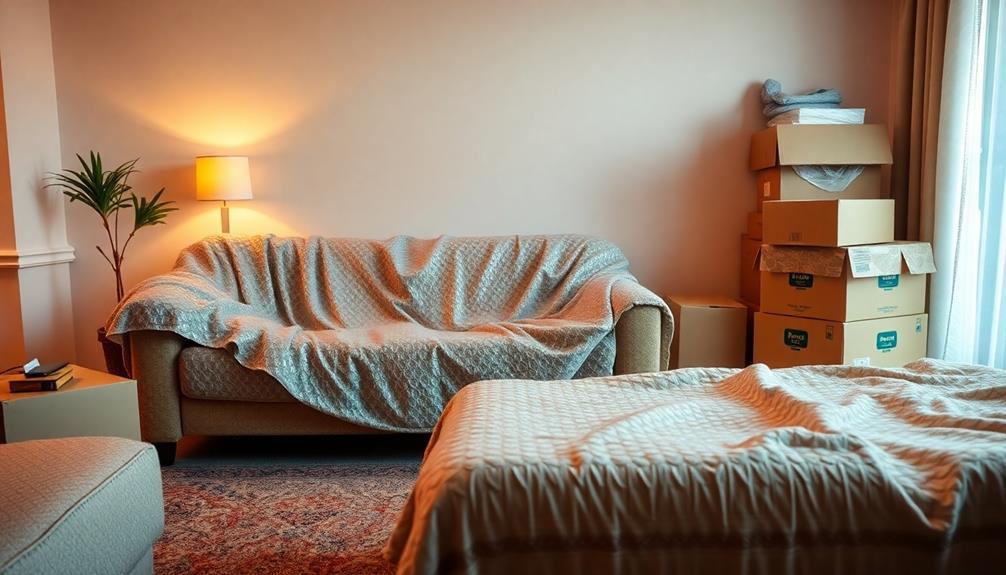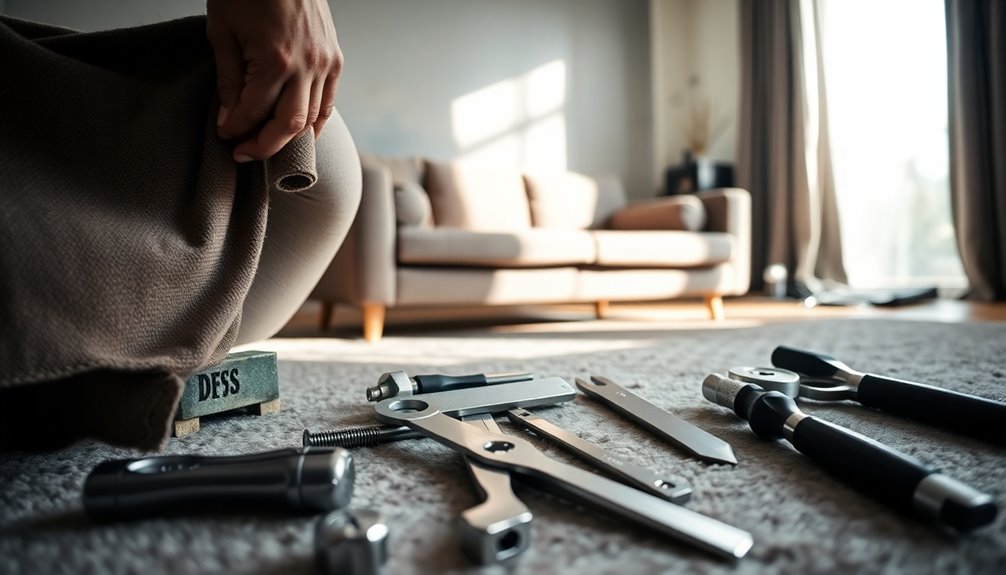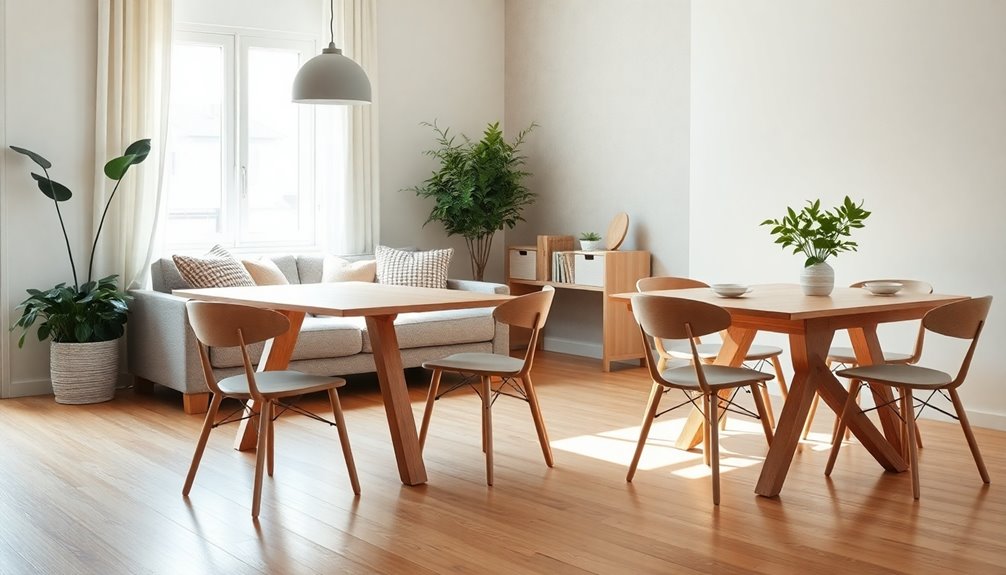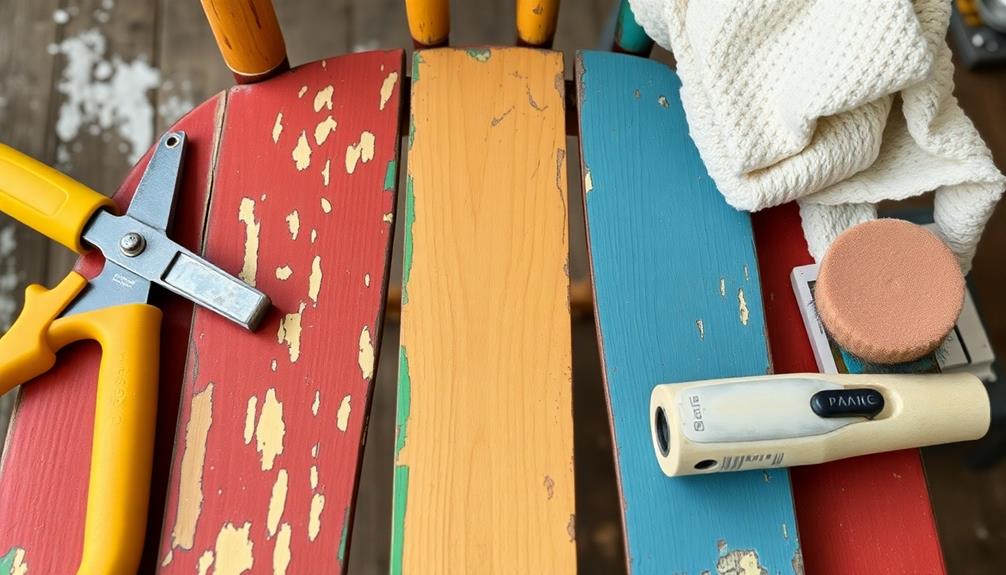To prepare furniture for moving, you’ll need to gather necessary supplies like moving blankets, bubble wrap, and packing tape. Protect vulnerable corners and edges by wrapping them with moving blankets or bubble wrap, and secure them in place with tape. Disassemble any removable parts and wrap them separately to ensure safe transport. For fragile items, individually wrap them in bubble wrap and add extra protection with cardboard corners. Clearly label all wrapped pieces to simplify the unpacking process. Make sure everything is well-protected to prevent any damage during the move. If you’re looking for advice on how to manage the unpacking process and learn about post-move best practices, there’s more information to explore.
Key Takeaways
- Use moving blankets to cover furniture and secure them with packing tape to protect against scratches and dents during transit.
- Wrap fragile items individually in bubble wrap for cushioning and reinforce with cardboard corners for added protection.
- Disassemble removable parts of furniture and wrap them separately to make handling easier and prevent damage.
- Label all wrapped items clearly to ensure easy identification during unpacking at your new location.
- Store reusable packing materials for future moves and dispose of non-reusable items responsibly after unpacking.
Importance of Furniture Wrapping
When moving, there's no denying that wrapping furniture is essential for protecting your valuable items. Properly wrapping your furniture helps shield it from dust, dirt, and scratches, ensuring everything stays in pristine condition during transport. This proactive approach can greatly reduce the risk of damage, saving you money on potential repairs or replacements and maintaining your furniture's value.
Additionally, ensuring that your furniture is well-protected can help prevent issues like cross-contact contamination, especially when items are stored in shared spaces or moving trucks preventing cross-contact on prep tables.
Using multiple layers of packing materials, like bubble wrap and moving blankets, provides robust cushioning and shock absorption. This extra protection is vital against bumps and scuffs that can happen during the moving process.
Plus, effective wrapping enhances organization, making it easier to identify items when you arrive at your new location.
Investing time in wrapping your furniture not only protects it during the move but also extends its lifespan and usability for future needs or resale. By taking these steps, you're ensuring your furniture remains in excellent condition, allowing you to enjoy it for years to come.
Essential Packing Supplies
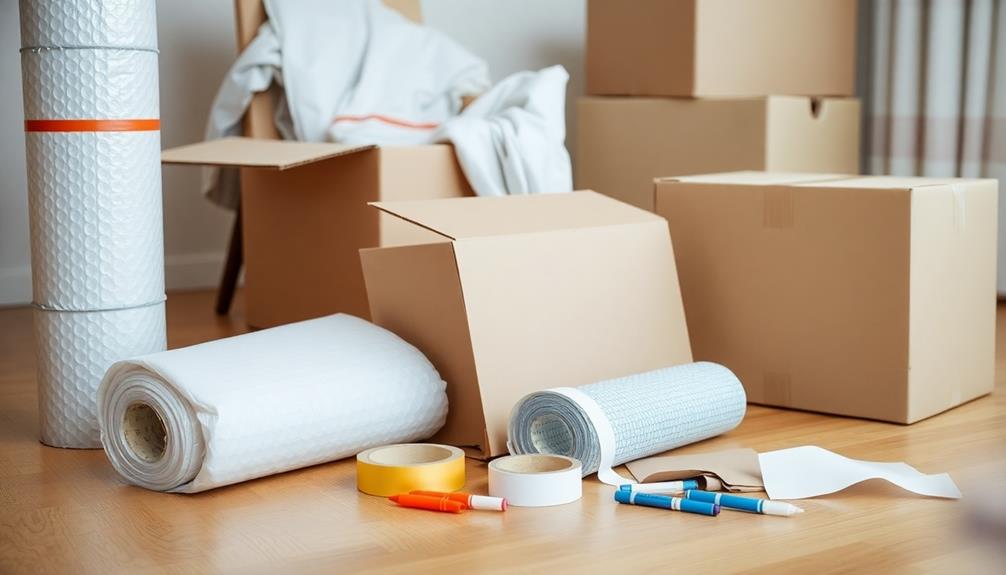
Packing your furniture properly requires the right supplies to guarantee everything stays safe during the move. Start by gathering moving blankets, which are fundamental for protecting furniture items from scratches and dents.
Bubble wrap is another must-have; it offers excellent cushioning for fragile items. Additionally, consider using an air purifier during the move to improve air quality and reduce allergens that could be stirred up. air purifier maintenance tips can help make sure your environment remains clean.
You can also use stretchable plastic wrap to secure everything tightly, preventing any shifting during transit. Don't forget packing tape to seal your wrapped items securely. It's vital for keeping everything intact.
For upholstered pieces like sofas and mattresses, invest in covers to shield them from dirt and spills. Corrugated cardboard sheets can provide additional protection for more delicate surfaces.
When it comes to small parts, consider sealing plastic bags for hardware and components to keep them organized and easily accessible during reassembly. Using multiple layers of protective materials, like combining bubble wrap with packing paper, enhances cushioning and defense against damage.
Effective Wrapping Techniques
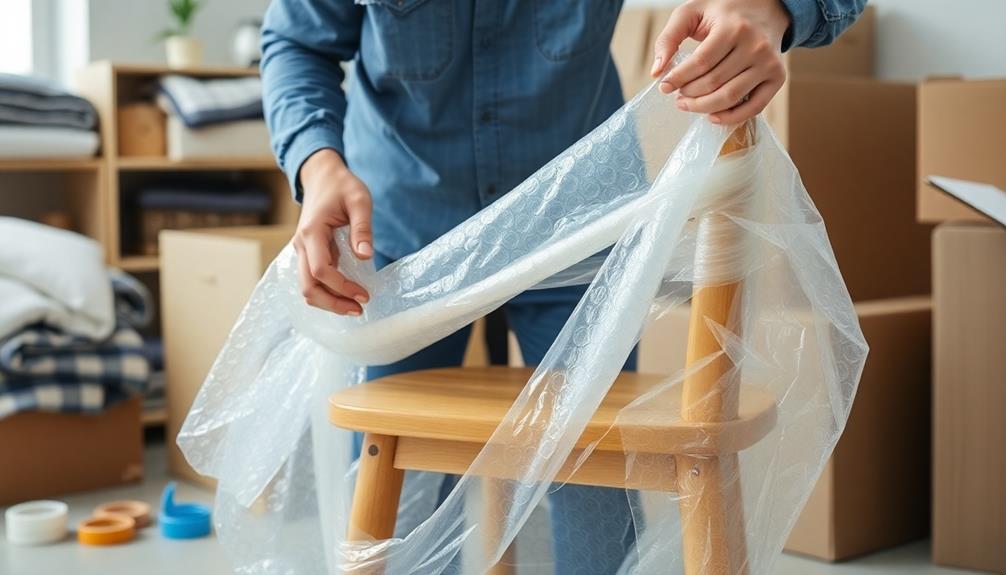
With the right supplies gathered, it's time to focus on effective wrapping techniques to guarantee your furniture arrives at your new home in perfect condition.
Start by using moving blankets or multiple layers of bubble wrap to wrap your furniture, ensuring that all corners and edges are well-covered. This not only cushions surfaces but also helps protect your furniture during transport. For that extra layer of protection, secure the blankets tightly with packing tape or stretch film, particularly around vulnerable areas like the arms and legs of furniture.
Additionally, consider your pets during the move; ensuring their safety and comfort is essential, as discussed in proper pet care.
If you have any removable parts, disassemble them and wrap them separately to make handling easier. For fragile items such as mirrors or glass surfaces, reinforce them with cardboard corners and cover them in bubble wrap before securing everything with tape.
Don't forget to label each wrapped item clearly for easy identification during unpacking.
Lastly, consider using eco-friendly packing materials, like reusable furniture wrapping paper. This helps protect your furniture while being mindful of the environment. Additionally, opt for materials like biodegradable packing peanuts or recycled cardboard boxes to further reduce your environmental footprint. Being conscious of your environmental impact also extends to knowing how to dispose of furniture responsibly, such as donating, selling, or recycling it instead of sending it to a landfill. Taking these steps not only minimizes waste but also supports sustainable living practices.
Specialized Protection for Fragile Items
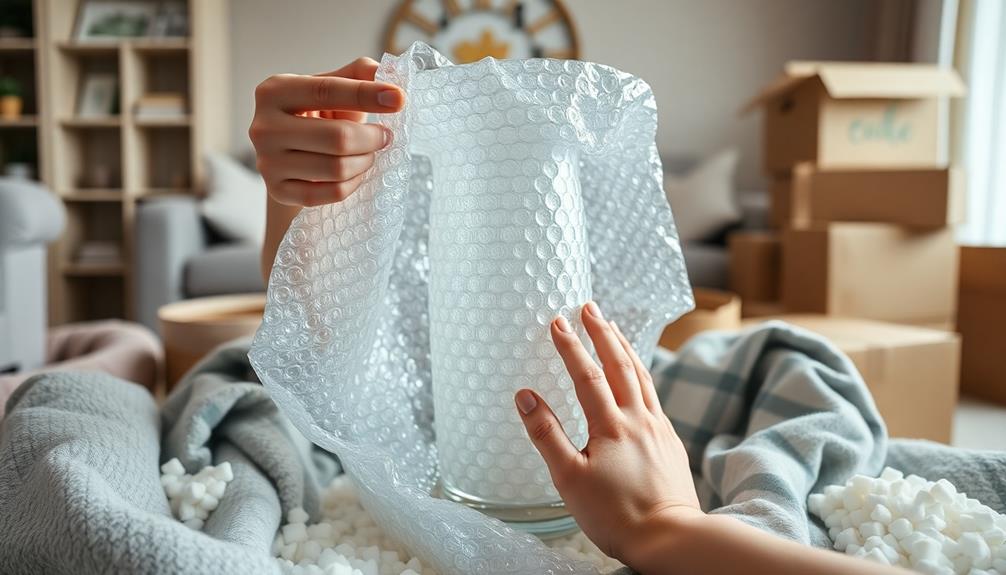
Fragile items like glassware, ceramics, and mirrors require specialized protection to prevent damage during your move. Start by wrapping each item individually in bubble wrap or foam for cushioning. Guarantee you reinforce the corners and edges, as these areas are the most prone to impact.
Avoid overpacking boxes with fragile items; instead, use packing paper or peanuts to fill empty spaces, minimizing movement and reducing the risk of damage.
For mirrors and picture frames, create an "X" pattern with masking tape across the glass to help prevent shattering. Cover the edges with cardboard for added protection.
When it comes to transporting these fragile items, always store them upright whenever possible. Layer bubble wrap with packing paper to prevent sticking and guarantee a smooth surface.
Lastly, consider using plastic wrap or moving blankets to provide extra cushioning around boxes containing fragile items. This specialized protection makes a significant difference in keeping your belongings safe during the move.
Managing Post-Move Unpacking
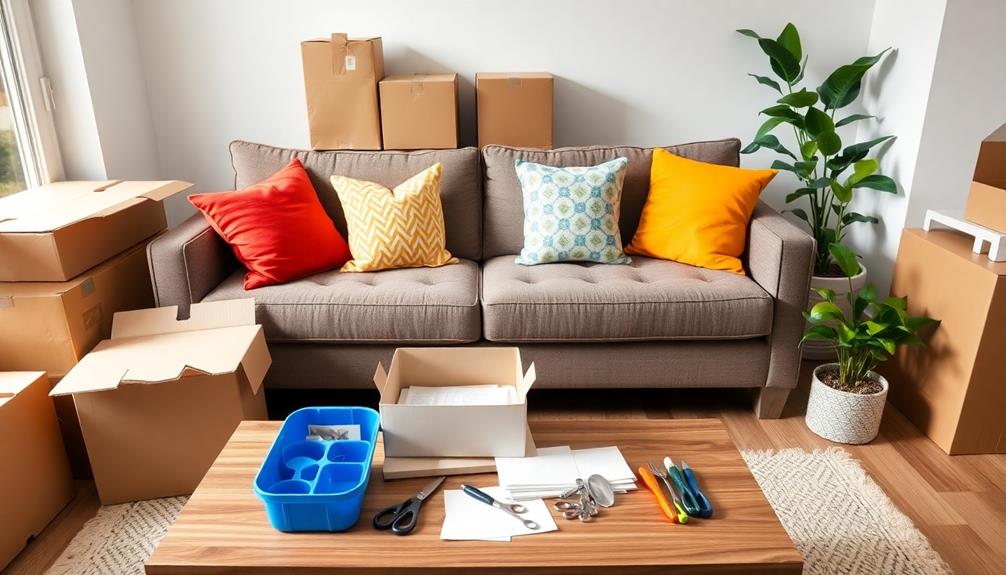
After moving day, jumping straight into unpacking can help you settle into your new home more quickly. Start by unwrapping your items promptly to prevent any damage from prolonged exposure to packing materials.
As you unpack, assess the condition of your furniture and other wrapped items to identify any issues that may have occurred during transport.
To enhance efficiency, organize and label unpacked items according to their designated rooms. This will streamline your post-move unpacking process, making it easier to set up your space.
While unpacking, take a moment to clean your new home and the unpacked items, ensuring everything is fresh and ready to use.
Once you've finished unpacking, clean and store any reusable wrapping materials, like moving blankets and bubble wrap, for future use. This can save you costs on packing supplies next time you move.
Dispose of non-reusable packing materials responsibly, sorting any recyclable items and placing them in the appropriate bins.
Frequently Asked Questions
Should You Wrap Your Furniture Before Moving?
Yes, you should wrap your furniture before moving. It protects against scratches and dirt, keeps items organized, and guarantees they arrive in great condition. Plus, it makes disassembly and transport easier. You won't regret it!
How to Wrap up a Couch for Moving?
Imagine your couch cocooned in layers of protection, safe from harm. You'll want to remove cushions and legs first, then cover it with blankets, bubble wrap, and shrink wrap for a secure, snug fit. To ensure a smooth moving process, taking your time during the preparation phase will minimize any potential damage to delicate upholstery or frame. If it’s a sectional, you may also need to look into **how to separate sectional sofa** pieces effectively by unlocking connectors located at the joins or disassembling it further for ease of transport. With everything securely wrapped and separated, your sofa will be ready for the next stage of the move or storage. Once you arrive at your destination, it’s time to carefully unwrap each piece and reassemble the sofa. If you’re unsure, don’t forget to refer to guides on **how to assemble your sofa** to ensure that you’re putting everything back together properly, paying attention to reattaching legs, cushions, and connectors if it’s a sectional. With patience and attention to detail, your couch will be back in place, looking just as good as it did before.
What Do Movers Use to Wrap Furniture?
Movers typically use moving blankets, bubble wrap, and plastic stretch wrap to protect your furniture. They also rely on packing tape to secure everything, while corrugated cardboard sheets help safeguard corners from damage during transit.
Does Shrink Wrap Damage Furniture?
You wouldn't want your precious heirlooms ruined, right? Shrink wrap can damage furniture if it traps moisture or compresses fabric. Always test it first and consider using protective padding to safeguard your items.
Conclusion
Wrapping your furniture isn't just about protection; it's an essential step that can save you time and money in the long run. By using the right supplies and techniques, you're not just preventing scratches and dents—you're also preserving the value of your items. Studies show that well-wrapped furniture can reduce damage by up to 80%. So, take the time to wrap your pieces carefully, and you'll thank yourself later when it's time to unpack and enjoy your new space.
